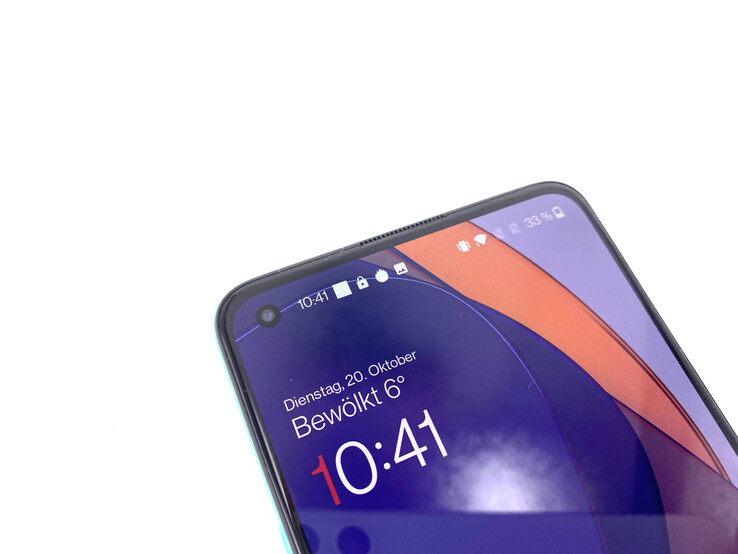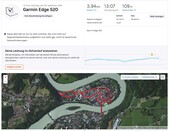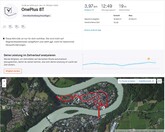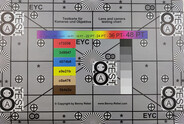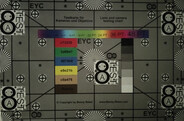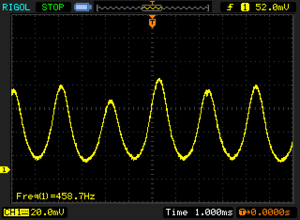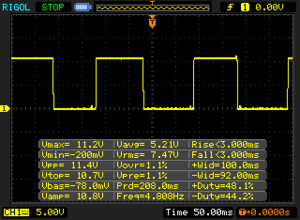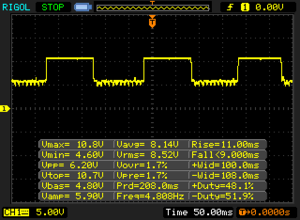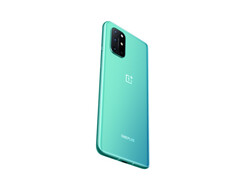Breve Análise d Smartphone OnePlus 8T – Carga mais rápida por menos dinheiro
Comparison Devices
Avaliação | Data | Modelo | Peso | Unidade | Size | Resolução | Preço |
|---|---|---|---|---|---|---|---|
| 87.8 % v7 (old) | 10/2020 | OnePlus 8T SD 865, Adreno 650 | 188 g | 128 GB UFS 3.1 Flash | 6.55" | 2400x1080 | |
| 88.4 % v7 (old) | 06/2020 | OnePlus 8 SD 865, Adreno 650 | 180 g | 256 GB UFS 3.0 Flash | 6.55" | 2400x1080 | |
| 86.5 % v7 (old) | 09/2019 | Apple iPhone 11 A13 Bionic, A13 Bionic GPU | 194 g | 64 GB SSD | 6.10" | 1792x828 | |
| 88.1 % v7 (old) | 10/2020 | Samsung Galaxy Note20 Exynos 990, Mali-G77 MP11 | 192 g | 256 GB UFS 3.1 Flash | 6.70" | 2400x1080 | |
| 87.4 % v7 (old) | 04/2020 | Huawei P40 Kirin 990 5G, Mali-G76 MP16 | 175 g | 128 GB UFS 3.0 Flash | 6.10" | 2340x1080 | |
| 87.8 % v7 (old) | 06/2020 | Xiaomi Mi 10 SD 865, Adreno 650 | 208 g | 128 GB UFS 3.0 Flash | 6.67" | 2340x1080 |
Os Top 10
» Os Top 10 Portáteis Multimídia
» Os Top 10 Portáteis de Jogos
» Os Top 10 Portáteis Leves para Jogos
» Os Top 10 Portáteis Acessíveis de Escritório/Empresariais
» Os Top 10 Portáteis Premium de Escritório/Empresariais
» Os Top 10 dos Portáteis Workstation
» Os Top 10 Subportáteis
» Os Top 10 Ultrabooks
» Os Top 10 Conversíveis
» Os Top 10 Tablets
» Os Top 10 Smartphones
» A melhores Telas de Portáteis Analisadas Pela Notebookcheck
» Top 10 dos portáteis abaixo dos 500 Euros da Notebookcheck
» Top 10 dos Portáteis abaixo dos 300 Euros
Size Comparison
| Networking | |
| iperf3 transmit AX12 | |
| Huawei P40 | |
| OnePlus 8 | |
| Xiaomi Mi 10 | |
| Samsung Galaxy Note20 | |
| OnePlus 8T | |
| Apple iPhone 11 | |
| iperf3 receive AX12 | |
| Huawei P40 | |
| Xiaomi Mi 10 | |
| OnePlus 8 | |
| Samsung Galaxy Note20 | |
| OnePlus 8T | |
| Apple iPhone 11 | |
Comparação de imagens
Escolha uma cena e navegue pela primeira imagem. Um clique muda a posição nas telas sensíveis ao toque. Um clique na imagem ampliada abre o original em uma nova janela. A primeira imagem mostra a fotografia em escala do dispositivo de teste.
Hauptobjektiv BlumeHauptobjektiv UmgebungHauptobjektiv Low LightUltraweitwinkel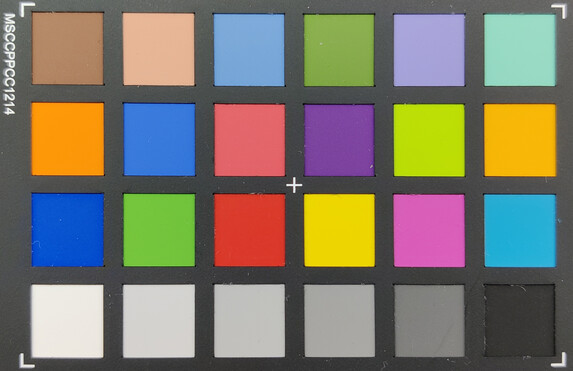
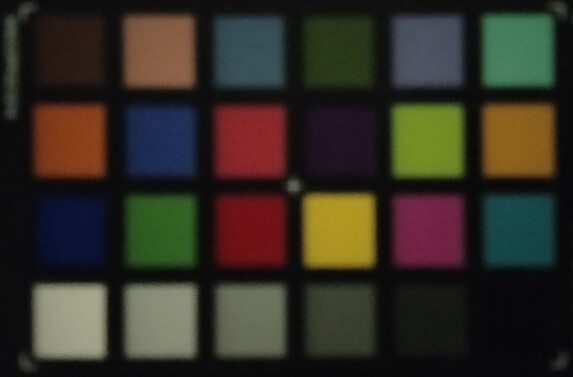
| |||||||||||||||||||||||||
iluminação: 91 %
iluminação com acumulador: 743 cd/m²
Contraste: ∞:1 (Preto: 0 cd/m²)
ΔE ColorChecker Calman: 0.89 | ∀{0.5-29.43 Ø4.78}
ΔE Greyscale Calman: 1.4 | ∀{0.09-98 Ø5}
97.2% sRGB (Calman 2D)
Gamma: 2.199
CCT: 6423 K
| OnePlus 8T AMOLED, 2400x1080, 6.6" | OnePlus 8 AMOLED, 2400x1080, 6.6" | Apple iPhone 11 IPS, 1792x828, 6.1" | Samsung Galaxy Note20 Super AMOLED Plus, 2400x1080, 6.7" | Huawei P40 AMOLED, 2340x1080, 6.1" | Xiaomi Mi 10 Super AMOLED, 2340x1080, 6.7" | |
|---|---|---|---|---|---|---|
| Screen | -6% | -5% | -76% | -89% | -11% | |
| Brightness middle (cd/m²) | 743 | 778 5% | 679 -9% | 610 -18% | 583 -22% | 786 6% |
| Brightness (cd/m²) | 734 | 783 7% | 671 -9% | 621 -15% | 593 -19% | 791 8% |
| Brightness Distribution (%) | 91 | 95 4% | 93 2% | 95 4% | 94 3% | 96 5% |
| Black Level * (cd/m²) | 0.68 | |||||
| Colorchecker dE 2000 * | 0.89 | 0.9 -1% | 0.8 10% | 2.4 -170% | 3.03 -240% | 1.1 -24% |
| Colorchecker dE 2000 max. * | 1.69 | 2.2 -30% | 2.4 -42% | 4.3 -154% | 5.33 -215% | 2.2 -30% |
| Greyscale dE 2000 * | 1.4 | 1.7 -21% | 1.1 21% | 2.8 -100% | 2 -43% | 1.8 -29% |
| Gamma | 2.199 100% | 2.25 98% | 2.24 98% | 2.09 105% | 2.301 96% | 2.26 97% |
| CCT | 6423 101% | 6481 100% | 6610 98% | 6368 102% | 6621 98% | 6315 103% |
| Contrast (:1) | 999 |
* ... menor é melhor
Cintilação da tela / PWM (modulação por largura de pulso)
| Tela tremeluzindo/PWM detectado | 458.7 Hz | ||
A luz de fundo da tela pisca em 458.7 Hz (pior caso, por exemplo, utilizando PWM) . A frequência de 458.7 Hz é relativamente alta, portanto, a maioria dos usuários sensíveis ao PWM não deve notar nenhuma oscilação. No entanto, há relatos de que alguns usuários ainda são sensíveis ao PWM em 500 Hz e acima, portanto, esteja atento. [pwm_comparison] Em comparação: 53 % de todos os dispositivos testados não usam PWM para escurecer a tela. Se PWM foi detectado, uma média de 8095 (mínimo: 5 - máximo: 343500) Hz foi medida. | |||
Exibir tempos de resposta
| ↔ Tempo de resposta preto para branco | ||
|---|---|---|
| 6 ms ... ascensão ↗ e queda ↘ combinadas | ↗ 3 ms ascensão | |
| ↘ 3 ms queda | ||
| A tela mostra taxas de resposta muito rápidas em nossos testes e deve ser muito adequada para jogos em ritmo acelerado. Em comparação, todos os dispositivos testados variam de 0.1 (mínimo) a 240 (máximo) ms. » 17 % de todos os dispositivos são melhores. Isso significa que o tempo de resposta medido é melhor que a média de todos os dispositivos testados (20.2 ms). | ||
| ↔ Tempo de resposta 50% cinza a 80% cinza | ||
| 20 ms ... ascensão ↗ e queda ↘ combinadas | ↗ 11 ms ascensão | |
| ↘ 9 ms queda | ||
| A tela mostra boas taxas de resposta em nossos testes, mas pode ser muito lenta para jogadores competitivos. Em comparação, todos os dispositivos testados variam de 0.165 (mínimo) a 636 (máximo) ms. » 32 % de todos os dispositivos são melhores. Isso significa que o tempo de resposta medido é melhor que a média de todos os dispositivos testados (31.6 ms). | ||
| PCMark for Android | |
| Work performance score (classificar por valor) | |
| OnePlus 8T | |
| OnePlus 8 | |
| Samsung Galaxy Note20 | |
| Huawei P40 | |
| Xiaomi Mi 10 | |
| Média Qualcomm Snapdragon 865 (10990 - 19989, n=22) | |
| Work 2.0 performance score (classificar por valor) | |
| OnePlus 8T | |
| OnePlus 8 | |
| Samsung Galaxy Note20 | |
| Huawei P40 | |
| Xiaomi Mi 10 | |
| Média Qualcomm Snapdragon 865 (9202 - 15299, n=23) | |
| AnTuTu v8 - Total Score (classificar por valor) | |
| OnePlus 8T | |
| OnePlus 8 | |
| Samsung Galaxy Note20 | |
| Huawei P40 | |
| Xiaomi Mi 10 | |
| Média Qualcomm Snapdragon 865 (527301 - 631025, n=24) | |
| Jetstream 2 - 2.0 Total Score | |
| Média da turma Smartphone (23.8 - 387, n=149, últimos 2 anos) | |
| Apple iPhone 11 (Safari Mobile 13.0) | |
| OnePlus 8T (Chrome 86) | |
| Média Qualcomm Snapdragon 865 (45.2 - 77, n=20) | |
| Samsung Galaxy Note20 (Samsung Browser 12.1) | |
| Huawei P40 (Huawei Browser 10.1) | |
| OnePlus 8 (Chrome 83) | |
| Xiaomi Mi 10 (Xiaomi Browser V11.4.23) | |
| JetStream 1.1 - Total Score | |
| Apple iPhone 11 (Safari Mobile 13.0) | |
| OnePlus 8T (Chrome 86) | |
| Média Qualcomm Snapdragon 865 (74.2 - 145.1, n=21) | |
| Xiaomi Mi 10 (Xiaomi Browser V11.4.23) | |
| Huawei P40 (Huawei Browser 10.1) | |
| Samsung Galaxy Note20 (Samsung Browser 12.1) | |
| OnePlus 8 (Chrome 83) | |
| Speedometer 2.0 - Result 2.0 | |
| Média da turma Smartphone (15.2 - 643, n=122, últimos 2 anos) | |
| Apple iPhone 11 (Safari Mobile 13.0) | |
| OnePlus 8T (Chome 86) | |
| Samsung Galaxy Note20 (Samsung Browser 12.1) | |
| Média Qualcomm Snapdragon 865 (30.6 - 74.5, n=19) | |
| Huawei P40 (Huawei Browser 10.1) | |
| Xiaomi Mi 10 (Xiaomi Browser V11.4.23) | |
| OnePlus 8 (Chrome 83) | |
| WebXPRT 3 - Overall | |
| Apple iPhone 11 (Safari Mobile 13.0) | |
| Média da turma Smartphone (38 - 380, n=31, últimos 2 anos) | |
| Xiaomi Mi 10 (Xiaomi Browser V11.4.23) | |
| OnePlus 8T (Chrome 86) | |
| Média Qualcomm Snapdragon 865 (97 - 127, n=23) | |
| Samsung Galaxy Note20 (Samsung Browser 12.1) | |
| OnePlus 8 (Chrome 83) | |
| Huawei P40 (Huawei Browser 10.1) | |
| Octane V2 - Total Score | |
| Média da turma Smartphone (2228 - 121337, n=197, últimos 2 anos) | |
| Apple iPhone 11 (Safari Mobile 13.0) | |
| Média Qualcomm Snapdragon 865 (14606 - 31224, n=23) | |
| Xiaomi Mi 10 (Xiaomi Browser V11.4.23) | |
| Huawei P40 (Huawei Browser 10.1) | |
| Samsung Galaxy Note20 (Samsung Browser 12.1) | |
| OnePlus 8T (Chrome 86) | |
| OnePlus 8 (Chrome 83) | |
| Mozilla Kraken 1.1 - Total | |
| OnePlus 8 (Chrome 83) | |
| Samsung Galaxy Note20 (Samsung Browser 12.1) | |
| Huawei P40 (Huawei Browser 10.1) | |
| Xiaomi Mi 10 (Xiaomi Browser V11.4.23) | |
| Média Qualcomm Snapdragon 865 (1623 - 2911, n=24) | |
| OnePlus 8T (Chrome 86) | |
| Média da turma Smartphone (257 - 28190, n=155, últimos 2 anos) | |
| Apple iPhone 11 (Safari Mobile 13.0) | |
* ... menor é melhor
| OnePlus 8T | OnePlus 8 | Samsung Galaxy Note20 | Huawei P40 | Xiaomi Mi 10 | Média 128 GB UFS 3.1 Flash | Média da turma Smartphone | |
|---|---|---|---|---|---|---|---|
| AndroBench 3-5 | 34% | 40% | 8% | 29% | 46% | 123% | |
| Sequential Read 256KB (MB/s) | 1659 | 1707 3% | 1683 1% | 1592 -4% | 1498 -10% | 1569 ? -5% | 2228 ? 34% |
| Sequential Write 256KB (MB/s) | 728 | 748 3% | 780 7% | 212.9 -71% | 680 -7% | 768 ? 5% | 1852 ? 154% |
| Random Read 4KB (MB/s) | 132.6 | 215 62% | 207.6 57% | 189.4 43% | 207 56% | 244 ? 84% | 296 ? 123% |
| Random Write 4KB (MB/s) | 121.4 | 203.9 68% | 233.8 93% | 197 62% | 215.9 78% | 243 ? 100% | 339 ? 179% |
| Sequential Read 256KB SDCard (MB/s) | 81.6 ? | 85.9 ? | |||||
| Sequential Write 256KB SDCard (MB/s) | 66.4 ? | 68.8 ? |
(±) A temperatura máxima no lado superior é 45 °C / 113 F, em comparação com a média de 35.2 °C / 95 F , variando de 21.9 a 247 °C para a classe Smartphone.
(±) A parte inferior aquece até um máximo de 43.8 °C / 111 F, em comparação com a média de 34 °C / 93 F
(+) Em uso inativo, a temperatura média para o lado superior é 25 °C / 77 F, em comparação com a média do dispositivo de 32.9 °C / ### class_avg_f### F.
OnePlus 8T análise de áudio
(+) | os alto-falantes podem tocar relativamente alto (###valor### dB)
Graves 100 - 315Hz
(-) | quase nenhum baixo - em média 66.7% menor que a mediana
(+) | o baixo é linear (0% delta para a frequência anterior)
Médios 400 - 2.000 Hz
(-) | quase nenhum médio - em média 66.7% menor que a mediana
(+) | médios são lineares (0% delta para frequência anterior)
Altos 2 - 16 kHz
(-) | quase nenhum máximo - em média 66.7% menor que a mediana
(+) | os máximos são lineares (0% delta da frequência anterior)
Geral 100 - 16.000 Hz
(-) | o som geral não é linear (117.1% diferença em relação à mediana)
Comparado com a mesma classe
» 87% de todos os dispositivos testados nesta classe foram melhores, 6% semelhantes, 6% piores
» O melhor teve um delta de 11%, a média foi 35%, o pior foi 134%
Comparado com todos os dispositivos testados
» 96% de todos os dispositivos testados foram melhores, 2% semelhantes, 2% piores
» O melhor teve um delta de 4%, a média foi 24%, o pior foi 134%
OnePlus 8 análise de áudio
(+) | os alto-falantes podem tocar relativamente alto (###valor### dB)
Graves 100 - 315Hz
(-) | quase nenhum baixo - em média 27% menor que a mediana
(±) | a linearidade dos graves é média (10.6% delta para a frequência anterior)
Médios 400 - 2.000 Hz
(±) | médios reduzidos - em média 5.4% menor que a mediana
(+) | médios são lineares (4.7% delta para frequência anterior)
Altos 2 - 16 kHz
(±) | máximos mais altos - em média 6.1% maior que a mediana
(+) | os máximos são lineares (3.1% delta da frequência anterior)
Geral 100 - 16.000 Hz
(±) | a linearidade do som geral é média (21.1% diferença em relação à mediana)
Comparado com a mesma classe
» 39% de todos os dispositivos testados nesta classe foram melhores, 8% semelhantes, 53% piores
» O melhor teve um delta de 11%, a média foi 35%, o pior foi 134%
Comparado com todos os dispositivos testados
» 58% de todos os dispositivos testados foram melhores, 7% semelhantes, 35% piores
» O melhor teve um delta de 4%, a média foi 24%, o pior foi 134%
| desligado | |
| Ocioso | |
| Carga |
|
Key:
min: | |
| OnePlus 8T 4500 mAh | OnePlus 8 4300 mAh | Apple iPhone 11 3110 mAh | Samsung Galaxy Note20 4300 mAh | Huawei P40 3800 mAh | Xiaomi Mi 10 4780 mAh | Média Qualcomm Snapdragon 865 | Média da turma Smartphone | |
|---|---|---|---|---|---|---|---|---|
| Power Consumption | -6% | -15% | 0% | -2% | 18% | -23% | -8% | |
| Idle Minimum * (Watt) | 1.1 | 0.9 18% | 0.56 49% | 0.92 16% | 1 9% | 0.53 52% | 1.133 ? -3% | 0.842 ? 23% |
| Idle Average * (Watt) | 1.5 | 2.3 -53% | 2.99 -99% | 1.5 -0% | 1.9 -27% | 1.46 3% | 2.23 ? -49% | 1.439 ? 4% |
| Idle Maximum * (Watt) | 1.7 | 2.33 -37% | 3.02 -78% | 1.54 9% | 2.4 -41% | 1.52 11% | 2.45 ? -44% | 1.624 ? 4% |
| Load Average * (Watt) | 4.6 | 3.5 24% | 4.17 9% | 5.49 -19% | 3.5 24% | 3.83 17% | 5.26 ? -14% | 7.03 ? -53% |
| Load Maximum * (Watt) | 9.4 | 7.68 18% | 5.44 42% | 9.99 -6% | 6.9 27% | 8.89 5% | 9.68 ? -3% | 11.3 ? -20% |
* ... menor é melhor
| OnePlus 8T 4500 mAh | OnePlus 8 4300 mAh | Apple iPhone 11 3110 mAh | Samsung Galaxy Note20 4300 mAh | Huawei P40 3800 mAh | Xiaomi Mi 10 4780 mAh | |
|---|---|---|---|---|---|---|
| Duração da bateria | -7% | 25% | 13% | 6% | -2% | |
| Reader / Idle (h) | 25.7 | 22.9 -11% | 46.1 79% | 34.5 34% | 34.4 34% | 29.8 16% |
| H.264 (h) | 18.4 | 18.3 -1% | 19.1 4% | 18.7 2% | 17.5 -5% | 18.8 2% |
| WiFi v1.3 (h) | 17.1 | 17.4 2% | 14.4 -16% | 9.8 -43% | 13.4 -22% | 11 -36% |
| Load (h) | 3.4 | 2.8 -18% | 4.5 32% | 5.4 59% | 3.9 15% | 3.8 12% |
Pro
Contra
Veredicto – Mais por menos
O OnePlus 8T oferece pequenas melhorias em comparação com seu já muito bom predecessor. Por exemplo, ele oferece uma tela com uma taxa de atualização de 120 Hz, uma câmera macro com uma resolução mais alta e uma lente adicional que fornece mais dados para fotos. No entanto, a qualidade da câmera não pode ser comparada à de seus concorrentes de ponta mais caros, pois as imagens não têm nitidez de detalhes.
Ficamos satisfeitos com o alto desempenho sem afogamento, a localização precisa, o carregamento muito rápido e a calibração precisa da tela. O novo software é atraente e oferece muitas mais opções de configuração, ao mesmo tempo que é fácil de usar para veteranos do Android.
O aparelho esquenta um pouco demais para o nosso gosto e seus alto-falantes estéreo oferecem uma qualidade de som apenas média. O Wi-Fi não é tão rápido quanto em outros dispositivos Wi-Fi 6. Os usuários também terão que se virar sem carregamento sem fio ou certificação IP.
O OnePlus 8T omite a maioria dos truques de ponta e concentra-se em sua proposta principal: muita potência e conectividade por um preço acessível.
Se você está procurando a melhor câmera para smartphone do mercado, o OnePlus 8T pode não ser a escolha certa para você. Embora produza imagens decentes de gama alta, outros fazem um trabalho ainda melhor. Se, por outro lado, você deseja o melhor desempenho e ótima conectividade com o mínimo de dinheiro, você está no lugar certo.
OnePlus 8T
- 08/31/2022 v7 (old)
Florian Schmitt




